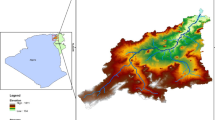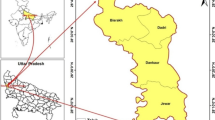Abstract
Food and Agriculture Organization (FAO)-land cover classification system (LCCS) is one of the open access water productivity system products that is widely used in global map**. In this study, we compared the performance of FAO-LCCS version 1.1 and version 1.2 (FAO-LCCS V. 1.1 and V. 1.2) images for monitoring and predicting LULC changes, mainly date palm plantation (DPP) pattern in Ziban region (Northeast Algeria). Three consecutive pairs of FAO-LCCS V. 1.1 and V. 1.2 images were used for monitoring LULC changes during the years 2009, 2012, and 2015. Decision tree algorithm classification was used to reclassify FAO-LCCS V. 1.1 and 1.2 images to five standard classes during the years 2009, 2012, and 2015. CA–Markov model was applied to simulate future DPP dynamics for the years 2018, 2021, 2024, 2027, and 2030. In case of FAO-LULC V. 1.2, there was no change in the five classes between all the studied years. In case of FAO-LULC V. 1.1, results revealed that from 2009 to 2012, 2012 to 2015, DPP cover increased with 0.44%, and ~ 1%, respectively, and it is expected to increase to 4.5% by 2030. For accuracy assessment, reclassification results and CA–Markov model were validated using kappa index statistics. More than 61% of overall accuracy was computed for each of the six FAO-LULC maps. CA–Markov model reached 88% of overall accuracy. The findings of this study showed reasonably good performance of the CA–Markov model. Besides. FOA-LCCS V. 1.1 data can be considered as an appropriate and useful data in studying LULC changes and vegetation growth at regional scale. These results represent a useful tool for limiting change land uses in the study area.








Similar content being viewed by others
References
Aburas MM, Ho YM, Ramli MF, Ash’aari ZH (2017) Improving the capability of an integrated CA–Markov model to simulate spatio-temporal urban growth trends using an analytical hierarchy process and frequency ratio. Int J Appl Earth Obs Geoinf 59:65–78. https://doi.org/10.1016/j.jag.2017.03.006
Aburas MM, Ho YM, Pradhan B, Salleh AH, Alazaiza MY (2021) Spatio-temporal simulation of future urban growth trends using an integrated CA–Markov model. Arab J Geosci 14(2):1–12. https://doi.org/10.1007/s12517-021-06487-8
Ackom EK, Adjei KA, Nii OS (2020) Monitoring land-use and land-cover changes due to extensive urbanization in the Odaw River Basin of Accra, Ghana, 1991–2030. Modeling Earth Syst Environ 6(2):1131–1143. https://doi.org/10.1007/s40808-020-00746-5
Afrasine GM, Melis MT, Buttau C, Arras C, Pistis M, Zerrim A, Guied M, Ouessar M, Essifi B, Zaied MB, Jlali A, Jarray H, Ghiglieri G (2017a) Classification methods for detecting and evaluating changes in desertification-related features in arid and semiarid environments. Euro-Mediterranean J Environ Integr 2(1):14. https://doi.org/10.1007/s41207-017-0021-1
Afrasinei GM, Melis MT, Buttau C, Bradd JM, Arras C, Ghiglieri G (2017b) Assessment of remote sensing-based classification methods for change detection of salt-affected areas (Biskra area, Algeria). J Appl Remote Sens 11(1):016025. https://doi.org/10.1117/1.JRS.11.016025
Aithal BH, Vinay S, Ramachandra TV (2018) Simulating urban growth by two state modelling and connected network. Model Earth Syst Environ 4(4):1297–1308. https://doi.org/10.1007/s40808-018-0506-1
Ajour S (2021) Evaluation of FAO’s water productivity portal (WaPOR) yield over the Beqaa valley, Lebanon. Dissertation. American University of Beirut
Akın A, Erdoğan MA (2020) Analysing temporal and spatial urban sprawl change of Bursa city using landscape metrics and remote sensing. Model Earth Syst Environ 6(3):1331–1343. https://doi.org/10.1007/s40808-020-00766-1
Al Naber M, Molle F (2017) Controlling groundwater over abstraction: state policies vs local practices in the Jordan highlands. Water Policy 19(4):692–708. https://doi.org/10.2166/wp.2017.127
Al-Khayri JM, Jain SM, Johnson DV (2015a) Date palm genetic resources and utilization. Africa and the Americas. Springer. https://doi.org/10.1007/978-94-017-9694-1
Al-Khayri JM, Jain SM, Johnson DV (2015b) Date palm genetic resources and utilization. Asia and Europe. Springer. https://doi.org/10.1007/978-94-017-9707-8
Al-Shaar W, Gérard JA, Nehme N, Lakiss H, Barakat LB (2021) Application of modified cellular automata Markov chain model: forecasting land use pattern in Lebanon. Model Earth Syst Environ 7(2):1321–1335. https://doi.org/10.1007/s40808-020-00971-y
Allahyari H, Salehi E (2020) Presentation of a suitable approach for green programming of urban ways through integrative method CA-Markov: case study—Azadi Street of Tehran. Iran Model Earth Syst Environ 6(1):373–382. https://doi.org/10.1007/s40808-019-00685-w
Azzouzi SA, Vidal-Pantaleoni A, Bentounes HA (2017) Desertification monitoring in Biskra, Algeria, with Landsat imagery by means of supervised classification and change detection methods. IEEE Access 5:9065–9072. https://doi.org/10.1109/ACCESS.2017.2700405
Azzouzi SA, Vidal-Pantaleoni A, Bentounes HA (2018) Monitoring desertification in Biskra, Algeria using Landsat 8 and Sentinel-1A images. IEEE Access 6:30844–30854. https://doi.org/10.1109/ACCESS.2018.2837081
Barros VR, Field CB (2014) Climate change 2014: Impacts, adaptation, and vulnerability Regional aspects. Part B. Cambridge University Press, London
Birta LG, Arbez G (2013) Simulation foundations. Methods and applications. Springer, London
Blatchford M, Mannaerts CM, Zeng Y, Nouri H, Karimi P (2020) Influence of spatial resolution on remote sensing-based irrigation performance assessment using WaPOR data. Remote Sens 12(18):2949. https://doi.org/10.3390/rs12182949
Bose A, Chowdhury IR (2020) Monitoring and modeling of spatio-temporal urban expansion and land-use/land-cover change using markov chain model: a case study in Siliguri Metropolitan area, West Bengal, India. Model Earth Syst Environ 6(4):2235–2249. https://doi.org/10.1007/s40808-020-00842-6
Bouguedoura N, Bennaceur M, Babahani S, Benziouche SE (2015) Date palm status and perspective in Algeria. In: Al-Khayri JM, Jain SM, Johnson DV (eds) Date palm genetic resources and utilization. Springer, Netherlands, pp. 125–168. https://doi.org/10.1007/978-94-017-9694-1_4.
Cherlet M, Hutchinson C, Reynolds J, Sommer S, von Maltitz G (2018) World Atlas of Desertification. Third ed. Publication Office of the European Union, Luxembourg. https://doi.org/10.2760/9205.
Cord A, Conrad C, Schmidt M, Dech S (2010) Standardized FAO-LCCS land cover map** in heterogeneous tree savannas of West Africa. J Arid Environ 74(9):1083–1091. https://doi.org/10.1016/j.jaridenv.2010.03.012
Di Gregorio A (2005) Land cover classification system: classification concepts and user manual: LCCS (vol 2). Food & Agriculture Org
Durand MJH, Barbut MM (1938) Carte de reconnaissance des sols d’Algérie: Biskra. Service Géographique de l’Armée (in French)
Eastman JR (2006) IDRISI Andes Tutorial. Clark Labs, Worcester
Eastman JR (2012) IDRISI Selva Tutorial. Clark University, Worcester
Falah N, Karimi A, Harandi AT (2020) Urban growth modeling using cellular automata model and AHP (case study: Qazvin city). Model Earth Syst Environ 6(1):235–248. https://doi.org/10.1007/s40808-019-00674-z
FAO (2008) Proceedings of the workshop on irrigation of date palm and associated crops. Damascus, Syria, May 27–30, 2007.
Gidey E, Dikinya O, Sebego R, Segosebe E, Zenebe A (2017) Cellular automata and Markov Chain (CA_Markov) model-based predictions of future land use and land cover scenarios (2015–2033) in Raya, northern Ethiopia. Model Earth Syst Environ 3(4):1245–1262. https://doi.org/10.1007/s40808-017-0397-6
Jia Z, Qin A (2021) A comparative research on three identification methods of scenic resources of tourism based on GF-2 image: a case study of Yesanpo National Park. Converter 384–398. https://doi.org/10.17762/converter.190
Kabite G, Muleta MK, Gessesse B (2020) Spatiotemporal land cover dynamics and drivers for Dhidhessa River Basin (DRB). Ethiopia Model Earth Syst Environ. https://doi.org/10.1007/s40808-020-00743-8
Keshtkar H, Voigt W (2016) A spatiotemporal analysis of landscape change using an integrated Markov chain and cellular automata models. Model Earth Syst Environ 2(1):1–13. https://doi.org/10.1007/s40808-015-0068-4
Khwarahm NR, Qader S, Ararat K, Al-Quraishi AMF (2021) Predicting and map** land cover/land use changes in Erbil/Iraq using CA–Markov synergy model. Earth Sci Inf 14(1):393–406. https://doi.org/10.1007/s12145-020-00541-x
Kumar N, Singh SK, Singh VG, Dzwairo B (2018) Investigation of impacts of land use/land cover change on water availability of Tons River Basin, Madhya Pradesh, India. Model Earth Syst Environ 4(1):295–310. https://doi.org/10.1007/s40808-018-0425-1
Lambin EF, Geist H, Rindfuss RR (2006) Introduction: local processes with global impacts. In: Lambin EF, Geist H (eds) Land-use and land-cover change. Springer, Berlin, pp 1–8
Malik A, Abdalla R (2017) Agent-based modelling for urban sprawl in the region of Waterloo, Ontario, Canada. Model Earth Syst Environ 3(1):7. https://doi.org/10.1007/s40808-017-0271-6
Markov A (1971) Extension of the limit theorems of probability theory to a sum of variables connected in a chain. The Notes of the Imperial Academy of Sciences of St. Petersburg, VIII Series, Physio-Mathematical College XXII
McNamara K, Belden C, Kelly T, Pehu E, Donovan K (2017) Introduction: ICT in agricultural development. https://doi.org/10.1596/978-1-4648-1002-2_Module1
Meraj G, Singh SK, Kanga S, Islam MN (2021) Modeling on comparison of ecosystem services concepts, tools, methods and their ecological-economic implications: a review. Model Earth Syst Environ. https://doi.org/10.1007/s40808-021-01131-6
Mihi A (2018) Etude écologique et cartographique de l’écosystème oasien par l’outil SIG et Télédétection: cas de l’oasis de Biskra, Algérie sud. Dissertation, University of Setif
Mihi A, Nacer T, Chenchouni H (2018) Monitoring dynamics of date palm plantations from 1984 to 2013 using Landsat time-series in Sahara Desert oases of Algeria. In: El-Askary HM et al (eds) Advances in remote sensing and geo informatics applications. Springer Nature, Switzerland, pp 225–228. https://doi.org/10.1007/978-3-030-01440-7_52
Mihi A, Tarai N, Chenchouni H (2019) Can palm date plantations and oasification be used as a proxy to fight sustainably against desertification and sand encroachment in hot drylands? Ecol Indic 105:365–375. https://doi.org/10.1016/j.ecolind.2017.11.027
Mihi A, Benarfa N, Arar A (2020) Assessing and map** water erosion-prone areas in northeastern Algeria using analytic hierarchy process, USLE/RUSLE equation, GIS, and remote sensing. Appl Geomat 12(2):179–191. https://doi.org/10.1007/s12518-019-00289-0
Mihi A, Tarai N, Benaradj A, Chenchouni H (2021) Spatiotemporal changes in Date palm oases of Algeria over the last century. In: El-Askary HM et al (eds) Research developments in geotechnics, geo-informatics and remote sensing. Springer Nature, Switzerland (accepted)
Mishra VN, Rai PK, Prasad R, Punia M, Nistor MM (2018) Prediction of spatio-temporal land use/land cover dynamics in rapidly develo** Varanasi district of Uttar Pradesh, India, using geospatial approach: a comparison of hybrid models. Appl Geomat 10(3):257–276. https://doi.org/10.1007/s12518-018-0223-5
Niya AK, Huang J, Kazemzadeh-Zow A, Naimi B (2019) An adding/deleting approach to improve land change modeling: a case study in Qeshm Island. Iran Arab J Geosci 12(11):333. https://doi.org/10.1007/s12517-019-4504-z
Pandey B, Joshi PK (2015) Numerical modelling spatial patterns of urban growth in Chandigarh and surrounding region (India) using multi-agent systems. Model Earth Syst Environ 1(3):1–14. https://doi.org/10.1007/s40808-015-0005-6
Parsa VA, Yavari A, Nejadi A (2016) Spatio-temporal analysis of land use/land cover pattern changes in Arasbaran Biosphere Reserve: Iran. Model Earth Syst Environ 2(4):1–13. https://doi.org/10.1007/s40808-016-0227-2
Ramankutty N, Graumlich L, Achard F, Alves D, Chhabra A, DeFries RS, Foley JA, Geist H, Houghton RA, Goldewijk KK, Lambin EF, Millington A, Rasmussen K, Reid RS, TurnerII BL (2006) Global land-cover change: recent progress, remaining challenges. In: Lambin EF, Geist H (eds) Land-use and land-cover change. Springer, Berlin, pp 9–39. https://doi.org/10.1007/3-540-32202-7_2
Sarkar A, Chouhan P (2020) Modeling spatial determinants of urban expansion of Siliguri a metropolitan city of India using logistic regression. Model Earth Syst Environ 6:2317–2331. https://doi.org/10.1007/s40808-020-00815-9
Sibanda S, Ahmed F (2021) Modelling historic and future land use/land cover changes and their impact on wetland area in Shashe sub-catchment, Zimbabwe. Model Earth Syst Environ 7(1):57–70. https://doi.org/10.1007/s40808-020-00963-y
Simons G, den Besten N, Droogers P, Lda HUB (2017) A first-order water productivity assessment for the APROVALE Project, Mozambique
Stewart BA, Peterson GA (2015) Managing green water in dryland agriculture. Agron J 107(4):1544–1553. https://doi.org/10.2134/agronj14.0038
Stewart BA, Thapa S (2016) Dryland farming: concept, origin and brief history. In: Farooq M, Siddique KHM (eds) Innovations in dryland agriculture. Springer, Cham, pp. 3–29. https://doi.org/10.1007/978-3-319-47928-6_1
Sulla-Menashe D, Gray JM, Abercrombie SP, Friedl MA (2019) Hierarchical map** of annual global land cover 2001 to present: the MODIS Collection 6 Land Cover product. Remote Sens Environ 222:183–194. https://doi.org/10.1016/j.rse.2018.12.013
Taiwo OJ (2021) Modelling the spatiotemporal patterns of urban sprawl in Ibadan metropolis between 1984 and 2013 in Nigeria. Model Earth Syst Environ. https://doi.org/10.1007/s40808-021-01095-7
Wanjala JA, Sichangi AW, Mundia CN, Makokha GO (2020) Modelling the dry season inundation pattern of Yala Swamp in Kenya. Model Earth Syst Environ 6(4):2091–2101. https://doi.org/10.1007/s40808-020-00816-8
Funding
This study was not funded by any source.
Author information
Authors and Affiliations
Corresponding author
Additional information
Publisher's Note
Springer Nature remains neutral with regard to jurisdictional claims in published maps and institutional affiliations.
Rights and permissions
About this article
Cite this article
Mihi, A. Dynamic simulation of future date palm plantation (Phoenix dactylifera L.) growth using CA–Markov model and FAO-LCCS data in Algerian dryland oases desert. Model. Earth Syst. Environ. 8, 3215–3230 (2022). https://doi.org/10.1007/s40808-021-01289-z
Received:
Accepted:
Published:
Issue Date:
DOI: https://doi.org/10.1007/s40808-021-01289-z




